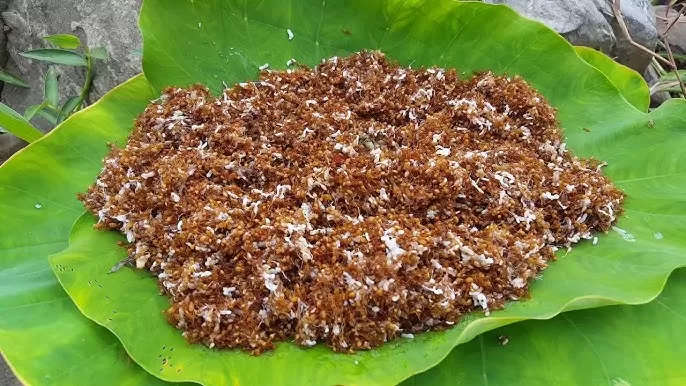In a culinary revelation, the renowned red ant chutney, relished by locals in Jharkhand, Odisha, and Chhattisgarh, has now been bestowed with the prestigious Geographical Indication (GI) tag. This recognition extends to seven distinct products from Orissa, encompassing Similipal Kai Chutney crafted from red weaver ants to the exquisite Kantimundi Brinjal. This diverse list also features five gastronomic delights alongside the inclusion of an embroidered Kapdaganj shawl and Lanjia Saura painting.

Red Ant Chutney: Significance of Geographical Indication (GI) Tag:
A product adorned with a GI tag signifies its origin in a specific geographical area, region, or country. These tags are granted as a testament to the product’s quality and uniqueness rooted in its distinct geographical origins. The authority responsible for conferring GI tags in India lies with the Department for Promotion of Industry and Internal Trade, Ministry of Commerce and Industry.
Red Ant Chutney – A Culinary Marvel:
In the rich tapestry of Indian cuisine, various states are celebrated for their unique and sometimes peculiar dishes. One such culinary marvel is the red ant chutney, which may initially raise eyebrows but holds significant cultural importance. This delectable chutney enjoys popularity among tribal communities in Odisha, Jharkhand, and Chhattisgarh, where it is relished with great enthusiasm. Notably, the recent conferment of the geographical indication has recognized its association with the Mayurbhanj district of Odisha.
The Making of Red Ant Chutney:
The preparation of red ant chutney involves a meticulous process. The red ants, known locally as chapra, are gathered from anthills found in the forests. The preparation includes not only the ants but also their eggs, enhancing the nutritional content. The ants and their eggs are ground with garlic and green chillies, and the resulting mixture is dried before being ground again into a fine chutney. The addition of tomatoes, coriander, salt, and chilli completes the preparation, delivering a spicy and flavorful condiment.
Nutritional Value and Medicinal Properties:
While the thought of consuming red ant chutney might intrigue many, its nutritional value is noteworthy. This unconventional chutney serves as a protein-rich source, and its consumption is associated with various medicinal benefits. The presence of formic acid in red ants contributes to preventing stomach diseases, and the chutney is also rich in calcium and zinc. Health experts acknowledge its potential in disease prevention and overall well-being.
The recognition of red ant chutney with a GI tag not only solidifies its cultural significance but also positions it as a unique and cherished culinary creation with global appeal. As people explore diverse gastronomic experiences, this indigenous delicacy stands as a testament to the richness and diversity of Indian cuisine.
Red Ant Chutney Recipe Unveiled
Embark on a culinary adventure with the unique and exotic Red Ant Chutney. Hailing from the heart of local traditions in Odisha, Jharkhand, and Chhattisgarh, this unconventional delicacy adds a spicy and flavorful twist to your palate. Dive into the intriguing process of creating this indigenous chutney, celebrated for its rich cultural roots and distinct taste.
Harvesting the Ingredients: A Challenging Endeavor
The journey of crafting Red Ant Chutney begins with the challenging task of collecting the key ingredient – red ants. Local harvesters brave the protective circles of male ants guarding egg-laying females, navigating through the forests. In the face of potential attacks, they endure painful bites while carefully harvesting the males, females, and their precious eggs. The collected ants are then added to bags, ready for the next step in the culinary process.
From Forest to Mortar: Crafting the Chutney Base
Once collected, the red ants and their eggs undergo a meticulous process. Harvesters crush and dry the insects before grinding them into a fine powder using a mortar and pestle. This forms the base for the chutney, showcasing the dedication of the villagers to their culinary craft.
A Symphony of Flavors: Ingredients and Preparation
The chutney comes to life with the infusion of various ingredients to the ant and egg mixture. Tomatoes, coriander, garlic, ginger, chili, salt, and a hint of sugar are skillfully blended to create a vibrant orange paste. Sometimes, villagers elevate the flavor profile by cooking the paste with a drizzle of oil and chopped onions, adding depth to the overall taste.
Packaging the Spice: Presentation and Market Presence
Ready to tantalize taste buds, the finished Red Ant Chutney finds its way to local markets. Vendors thoughtfully package the chutney in small packets made from sal leaves, ensuring its freshness and authenticity. A word of caution to first-time tasters – be prepared for an intense kick. The high levels of formic acid in the red ants, coupled with the carefully selected seasonings, make this chutney a spicy and unforgettable culinary experience.
Savor the Unique Fusion: Red Ant Chutney’s Distinctive Heat
As you explore diverse culinary landscapes, let the Red Ant Chutney be your guide to a truly distinctive taste adventure. This indigenous creation, born from local traditions and culinary expertise, stands as a testament to the richness and diversity of Indian cuisine. Embrace the spice, savor the complexity, and immerse yourself in the bold flavors of the Red Ant Chutney.